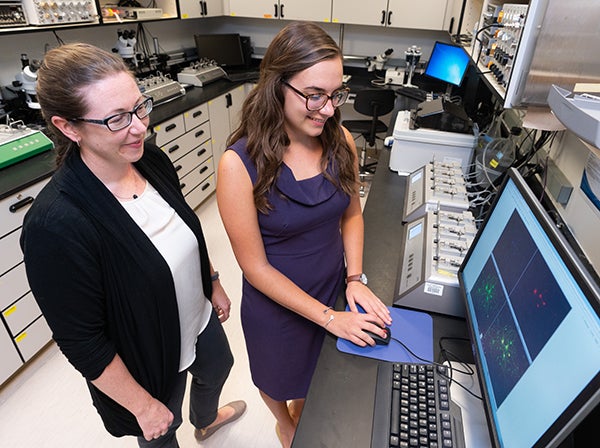Nearly $70K invested in undergraduate researchers
East Carolina University’s Office of Undergraduate Research announced that 42 students received fall 2019 Undergraduate Research and Creative Activity Awards, totaling nearly $70,000.
The awards provide support for faculty-mentored research and creative projects led by undergraduates in the biomedical sciences, STEM, social sciences, and the arts and humanities fields. This year, 15 awards were presented to STEM projects — 13 to the arts and humanities, nine to the social sciences, and five to the biomedical sciences.

Undergradaute researcher Jennifer McMains, center, and mentor Johanna Hannan review data in Hannan’s lab. McMains was one of 42 Undergraduate Research and Creative Activity Award recipients this fall, a 10% increase from the previous academic year. (Photo by Cliff Hollis)
Awards are given during the fall and spring of the academic year. Students apply for the award with a defined project narrative and budget justification summary that they’ve developed in collaboration with a faculty member.
Awards range from $150-2,000, depending on the project’s budget. Honors College recipients can receive up to $2,500 with additional support from the college.
The award may go toward project materials and cost, a stipend for the student, or be used for travel to conduct field or archival research. Award recipients are required to present their findings at venues including Undergraduate Day during ECU’s Research and Creative Achievement Week and the State of North Carolina Undergraduate Research and Creativity Symposium, in November.
This fall’s URCA award recipients are:
- James Barros, engineering, “Design of a patient orientation monitoring system”
- Natalie Bell, engineering, “Improvement of insulin-glucose model for personalized model predictive control”
- Justin Bailey Brinson, anthropology, “Classification of prehistoric artifacts in Pitt County”
- Mychaela Brown, neuroscience, “Learning problems in a mouse model of sleep impairment”
- Jonathan Carver, biology, “Role of Adamts9 in primordial germ cell migration and sex determination in zebrafish Danio rerio”
- Justin Cefalu, nutrition and dietetics, “Influence of cooking classes on nutrition literacy”
- Mina Chanakira, biochemistry, “FtrB and its role in the uptake of ferrous iron in Brucella”
- Rachel Cobb, elementary education, “Representation and construction of disabilities in children’s and young adult literature”
- Griffin Crail-Steinbaker, engineering, “Sensor-based anxiety monitoring system”
- Parth Dave, biology and molecular biology, “Investigation of conserved cysteines on fatty acid desaturase function”
- Conor Ferns, communication and film and video production, “Capture the moment: A documentary on an aging photojournalist”
- Dani Foster, biochemistry, “The Importance of Alexander von Humboldt’s conception of nature for climate science”
- Samantha Foster, public health, “Identifying context of high-risk opioid use through emergency room data”
- Brennan Huggins, biochemistry and chemistry, “Inhibition of ice crystallization using fluorescent antifreeze peptides”
- Sarah Kautz, public health, “LAST: Leisure activity step tracking study”
- Patrick Klitsch, textile design, “Vyschyvanko: Identity through dress”
- Ananya Koripella, public health and Hispanic studies, “Elucidating the role of BRCA1 in muscle satellite cells”
- Caleb Lockamy, engineering, “Solar and blue energy harvesting for desalination”
- Taylor Malachowski, biology and chemistry, “Does male germ cell development require RA?”
- Jennifer McMains, public health, “Neuritogenesis following radiation and castration”
- Conner Mikitka, nutrition and dietetics, “Influence of hyperglycemia condition of matrix remodeling responses of macrophages”
- Mariah Mook, engineering, “Reinforcement learning for a data-driven insulin pump”
- David Murray, biology, “Development of facile synthetic methods to incorporate novel unnatural amino acids into user-designed peptides with unique functionalities”
- Brooke Palmer, theatre arts, “Performing in American Sign Language – ‘The Magic of Winter from Around the World’”
- Kaylee Patterson, biology, “Characterizing the role of Tnpo-SR in oogenesis”
- Alexandria Perry, public health, “College male HPV/HPV vaccine study”
- Naimi Pothiwala, public health, “Mitochondrial phenotyping of leukemia”
- Kiersten Radford, public health, “Lung cancer screening adherence among black immigrants in the United States”
- Arvind Rajan, biochemistry and chemistry, “Determining the ketogenic diet-driven gene transcription in the normal and hypertrophic heart”
- Nikita Revankar, public health, “Building a technology based steam learning community”
- Dylan Sampson, exercise physiology, “Effects of distracted jump training on mechanical differences in a jump-landing task”
- Anuj Sanghvi, engineering, “Patient-specific models for perioperative planning”
- Kendall Schunk, nursing, “Cardiovascular disease and diabetes in lung cancer”
- Addison Siemon, anthropology and multidisciplinary studies, “Embattled & burned: New discoveries at Brunswick”
- Stephen Sugarbaker, engineering, “Valorization of waste peanut skins: Extraction of bioactive compounds”
- Shyam Sutariya, neuroscience and biochemistry, “Visualization of the anti-inflammatory effects of cannabidiol post neuronal damage”
- Bailey Thomas, engineering, “The role of ChemR23 in ozone-induced pulmonary inflammation and injury”
- Elizabeth Viverette, physics, “Cryo-electron microscopy and fibrinogen structure”
- Bridget Ward, engineering, “Computer-assisted image analysis of echocardiography in pulmonary hypertension patients”
- Abigail Ware, psychology, “Mental health risk factors for postpartum depression”
- Zachary Warfel, biology, “Interannual variability in morphometric condition of larval Atlantic croaker and mojarra as a function of temperature, zooplankton abundance, and seasonality”
- Savanna Williams, biology, “Use of hydrogels to emulate lymphedema tissue densities for use in AERO device”
Learn more about ECU’s URCA awards online. For more information on individual projects, visit the 2019 Fall URCA webpage.
-by Matt Smith, University Communications